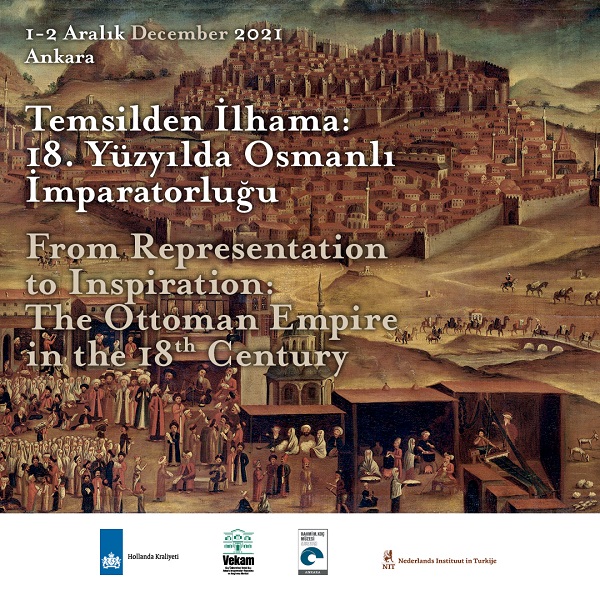From Representation to Inspiration: The Ottoman Empire in the 18th Century
November 22, 2021
Embassy of the Kingdom of the Netherlands in Türkiye, Koç University Vehbi Koç Ankara Studies Research Center ( VEKAM), Rahmi M. Koç Museum in Ankara and Netherlands Institute in Türkiye (NIT), are thrilled to announce From Representation to Inspiration: The Ottoman Empire in the 18th Century symposium to celebrate; extension of the display of the Ankara View painting from the Rijksmuseum collection which is temporarily back in Ankara in 2018 and to promote research on Europe’s cultural heritage and art and to provide a perspective to Ottoman Culture through the 18th century.
On this occasion, we are glad to reintroduce the View of Ankara painting by an online symposium to go through the Ottoman Empire in the 18th century on 1-2 December 2021 in various thematic contexts inspired by the painting (social life, women, trade and transportation) with academic lectures enlightening the different aspects of the painting while providing a platform to meet enthusiasts with the painting’s artistic and cultural reflections. We believe that the symposium will give a general insight on the illustrated historical time period and will pave the way for the new discussions, studies and collaborations.
The artistic performance titled “TAKT”, which aims to feature the layered identity of the painting by using multi-disciplines by artists Deniz Atlı, Oğuz Öner and Umut Kambak will broadcast online on zoom and VEKAM’s youtube channel during the symposium and will be available at the Rahmi M. Koç Museum in Ankara for a month for its visitors.
*The symposium will be held online through zoom (GMT +3, İstanbul) and will broadcast live on VEKAM Youtube channel.
**Registration is required. Simultaneous translation will be available.
***VEKAM YOUTUBE CHANNEL
December 1, 2021 // Opening Program ( 03.30 pm)
To watch the opening program in English on Youtube <<
To watch the opening program in Turkish on Youtube <<
December 2, 2021 // From Representation to Inspiration: The Ottoman Empire in the 18th Century Symposium Program (10.00 am)
to watch the symposium program in English on Youtube <<
to watch the symposium program in Turkish on Youtube <<
ABOUT THE VIEW OF ANKARA PAINTING
The View of Ankara from the Rijksmuseum collection has been one of the key paintings regarded as the only visual document revealing the 18th century Ankara’s topography, architecture, daily life, and the mohair production. The View of Ankara is not only important for Ankara studies as being the oldest painting of Ankara that is known but also it depicts various stages of mohair production such as the Angora Goats being shorn, spinning, weaving, and it also points to the mohair trade which had been pivotal for the economy of the city. It also implies to the trade relations between the Netherlands and the Ottoman Empire based on mohair manufacture.The painting is dated to the 18th century and its painter is unknown. Most probably, it was commissioned by a Dutch trade company resident in Ankara to a Dutch artist and then transported to the Netherlands. For many years, the View of Ankara was in the Levantsche Handel headquarters at the Dam Square in Amsterdam. The painting’s 20thcentury adventure began when it was included into the Rijksmuseum collection in 1902. Then, it was recorded in the museum registry as a View of Aleppo.
Sixty-eight years later, art historian Semavi Eyice saw a reproduction of the painting in the book De “Turkse” schilderijen van J.B. Vanmour en zinjschool, De Verzameling van Cornelis Calkoen, ambassadeur bij de Hoge Porte, written by Remmet Van Luttervelt and detected some inconsistencies: “The city of Aleppo has a diverse ambience, but this cannot be found in the View of Ankara. The second point that differs the view from Aleppo is the Angora Goats located at the lower right corner, as Angora Goats cannot survive in Aleppo’s climate.” In addition, the fact that the architectural structures depicted in the painting matched Ankara buildings established that this, indeed, was a view of Ankara.
In 2018, with the Koç University Vehbi Koç Ankara Studies Research Center’s (VEKAM) exhibition titled “Weaving the History: Mystery of a City, Sof” (11 May-16 September 2018) which is curated by Prof. Filiz Yenişehirlioğlu – Dr. Gözde Çerçioğlu Yücel and opened at the Rahmi M. Koç Museum in Ankara, the The View of Ankara painting from the Rijksmuseum collection which is temporarily back in Ankara with the efforts of Turkish Ministry of Culture, Embassy of the Kingdom of the Netherlands in Türkiye, Rahmi M. Koç Museum Ankara and Koç University VEKAM, as the central piece of the exhibition focusing on the premium product called sof and the history of the Angora Goat and mohair manufacture in Ankara. The exhibition supported with various institutions and people as well and drew intense interest while paving the way for various studies both in academic and artistic way. The exhibition Weaving History: Mystery of a City – Sof was designated as an exemplary and successful project from Türkiye during “Working Conference on Culture for Egypt, Morocco, Russia and Türkiye” focusing on international cultural collaboration and organized by Dutch Culture on June 19th 2018 in Theater aan Het Spui in the Netherlands. The display of the painting has been decided to extend until 2022.
